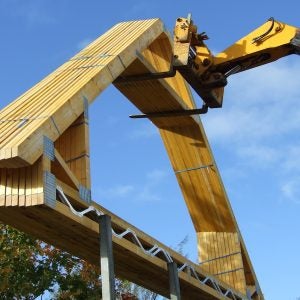Wood for Good’s Wood First campaign was given a “positive and receptive” hearing by representatives of the London Borough of Hackney at a special symposium last week.
Wood for Good had been invited to put on the event after making an initial presentation to the council on Wood First, which urges local authorities to express a preference for timber and wood products in planning guidelines to help them meet their low carbon and broader environmental goals.
“We had an audience of about 75 and were very encouraged by the response,” said Wood for Good head of public affairs Dave Hopkins. “Hackney head of planning Graham Loveland explained that the council was reviewing its entire master planning policy to future proof it against coming low carbon legislation and it was refreshing to see councillors so engaged with the benefits of using timber.”
The event was addressed by Mr Hopkins and Wood for Good chairman John Kissock. It also included presentations by timber building system suppliers, including KLH, and timber-oriented architects, including Andrew Waugh of Waugh Thistleton, the practice behind the nine-storey, cross-laminated-timber Murray Grove Tower in Hackney.
“If anything, the architects are more enthusiastic advocates for timber and than the timber industry itself!” said Mr Hopkins.”And what really grabbed the audience’s attention was that their emphasis wasn’t just on the carbon, low energy input and life cycle analysis benefits of timber in construction, but the practical advantages. They emphasised speed and ease of build, and the airtightness and low operational energy of timber construction systems and their suitability for the densely built urban environment.”
Following the symposium, he added, Hackney planning deparment would “review all the [Wood First] evidence”, draft a policy and put it out to public consultation.
Wood for Good is now urging the timber sector to promote Wood First more widely and give the campaign leads at other local authorities which may be receptive to a Hackney-style presentation.
“What we are emphasising to the industry is how this campaign can benefit timber across the board,” said Mr Hopkins. “If wood is a favoured material for construction, the likelihood is that this will stimulate demand for other timber products too; flooring, joinery and so on. A rising tide floats all boats.”






